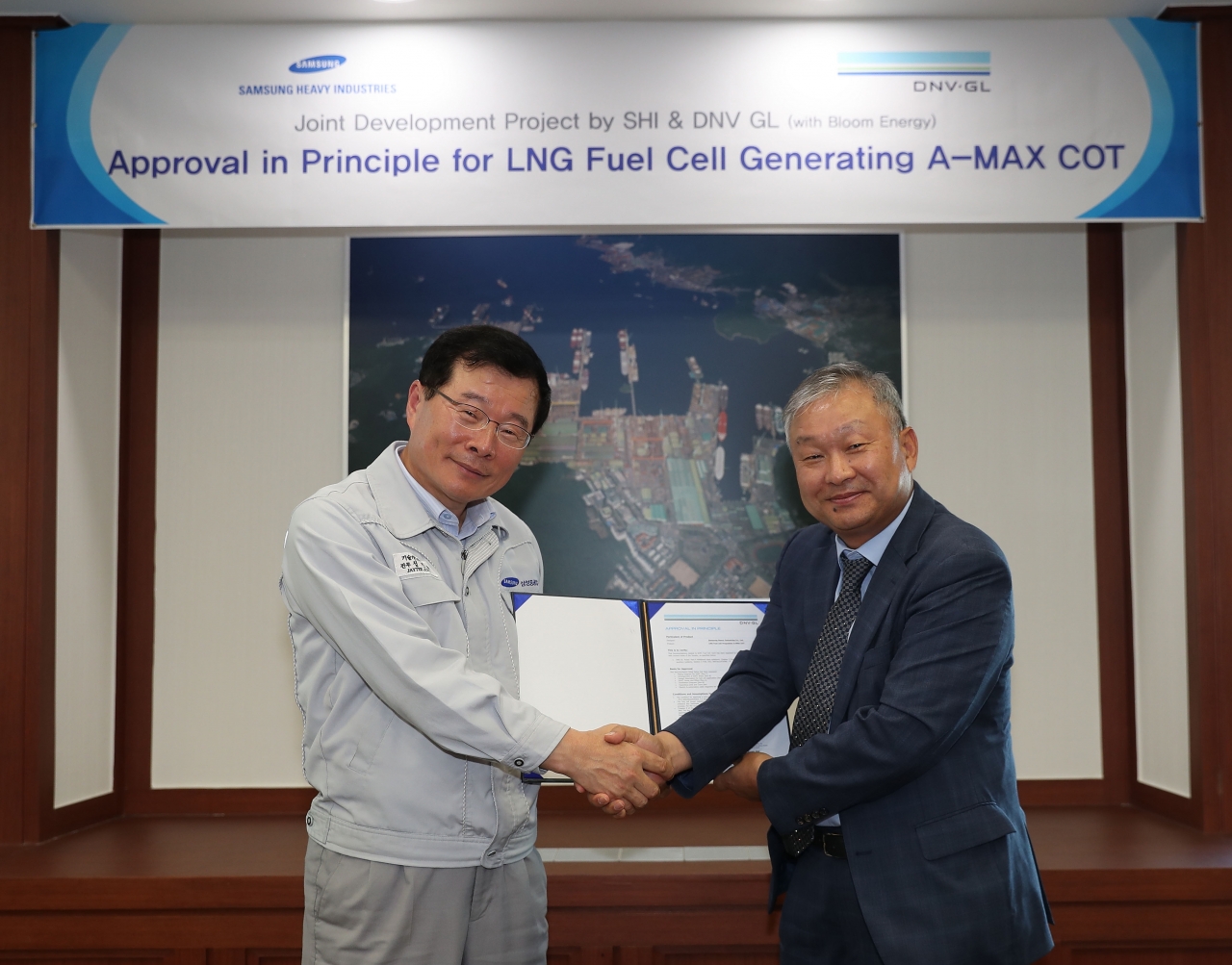
삼성중공업이 강력한 온실가스 배출규제에 대응할 수 있는 연료전지 적용 원유운반선을 세계 최초로 개발해 친환경 선박시장 공략에 박차를 가하고 있다.
삼성중공업은 노르웨이 독일 선급인 DNV GL社로부터 '연료전지(Fuel Cell) 적용 아프라막스급 원유운반선'에 대한 기본승인을 획득했다고 26일 밝힘. 선급 기본승인은 선박 기본설계의 기술적 정합성을 검증하는 절차로, 해당 선박과 기술에 대한 공식 인증을 받음으로써 본격적인 수주 활동이 가능하다.
이번에 개발한 연료전지 선박은 기존 발전기 엔진을 LNG를 연료로 사용하는 고체산화물연료전지(SOFC, Solid Oxide Fuel Cell)로 대체해 발전 효율을 높이고 온실가스 배출량을 획기적으로 줄인 친환경 선박이다.
기존 아프라막스급 원유운반선의 3MW 발전기 엔진을 연료전지로 대체할 경우 온실가스 배출량을 45% 이상 줄일 수 있으며, 이는 내연기관 자동차 약 10,000대를 줄이는 효과와 같다.
삼성중공업은 △고체산화물연료전지를 처음으로 상용화한 美 블룸에너지社와의 공동연구로 시스템 안정성을 높였으며 △연료전지용 연료공급시스템 및 전력제어 시스템 등 핵심 공정을 자체 개발했다. 또한 기존 엔진에 비해 부피가 큰 연료전지를 선체 형상의 변경 없이 선내 최적 배치에 성공함으로써 세계 최초로 연료전지 원유운반선에 대한 기본승인을 받게 됐다.
한편, 고체산화물연료전지는 LNG뿐만 아니라 수소(H2)도 연료로 사용 가능한 장치로, 향후 온실가스 배출 제로(Zero emission)인 '수소 연료전지 선박' 건조를 위한 기반 기술을 확보한 것으로도 평가됐다.
김경희 삼성중공업 의장설계팀장(상무)은 "향후 온실가스 배출 규제의 단계적 시행이 예정된 바, 선박의 연료전지 도입은 필연적"이라며, "이번 인증은 삼성중공업이 선박 연료전지 기술을 가장 먼저 확보함으로써 관련 시장 선점 가능성이 매우 높아졌다는 것을 의미"한다고 강조했다.
국제해사기구(IMO)는 지난 2008년 선박에서 배출되는 온실가스를 줄이기 위해 단계별로 저감 목표치(EEDI, Energy Efficient Design Index)를 정하고, 선박 설계 단계부터 목표치를 만족하도록 강제하고 있다.
이에 따라 IMO에 등록된 모든 선박은 2008년 온실가스 배출량 대비 2015년부터 10%, 2020년 20%, 2025년 30% 이상 반드시 배출을 감축해야 함. 최근 들어 2030년 40%, 2050년 70%까지 감축량을 늘리는 논의가 진행되는 등 규제가 강화되는 추세다.
[Focus] Samsung Heavy Industries has developed the world's first fuel cell crude carrier
DNV GL Advanced Technology Certification... Improving efficiency and lowering greenhouse gas emissions

Samsung Heavy Industries has developed the world's first fuel cell-applied crude oil carrier that can cope with strong greenhouse gas emission regulations, speeding up efforts to tap the eco-friendly ship market.
Samsung Heavy Industries announced on the 26th that it has obtained basic approval from DNV GL, a German shipping company, for the Aframax-class crude carrier with Fuel Cell. Basic ship design approval is a procedure to verify the technical consistency of the basic design of the ship, and by obtaining official certification for the vessel and technology, full-fledged order activities are possible.
The newly developed fuel cell vessel is an eco-friendly vessel that has replaced the existing generator engine with solid oxide fuel cell (SOFC) that uses LNG as fuel to increase efficiency of power generation and drastically reduce greenhouse gas emissions.
Replacing the 3MW generator engine of the existing Aframax-class crude carriers with fuel cells could reduce greenhouse gas emissions by more than 45 percent, the same effect as reducing about 10,000 internal combustion engine vehicles.
Samsung Heavy Industries has improved system stability through joint research with U.S. firm Bloom Energy, which commercialized solid oxide fuel cells for the first time, and has developed its own core processes such as fuel supply system and power control system for fuel cells. In addition, the company successfully deployed fuel cells, which are larger than conventional engines, without changing the shape of the hull, for the first time in the world to receive basic approval for fuel cell crude carriers.
Meanwhile, solid oxide fuel cell is a device that can be used as fuel not only for LNG, but also for hydrogen (H2) and it was also evaluated that it has secured a base technology for building "hydrogen fuel cell vessels," which is a zero greenhouse gas emission in the future.
"As future regulations on greenhouse gas emissions are scheduled to be implemented step by step, the introduction of fuel cells by ships is inevitable," said Kim Kyung-hee, head of Samsung Heavy Industries' design team. "This certification means that Samsung Heavy Industries has a very high chance of gaining upper hands in related markets by securing technologies for ship fuel cells."
In 2008, the International Maritime Organization (IMO) set a stage-by-step reduction target (EEDI) to reduce greenhouse gases emitted from ships, forcing them to meet the target from the stage of ship design.
Accordingly, all ships registered with IMO must reduce their emissions by 10 percent from 2015, 20 percent by 2020 and 30 percent by 2025. In recent years, the government has been talking about increasing the reduction to 40 percent in 2030 and 70 percent in 2050.


